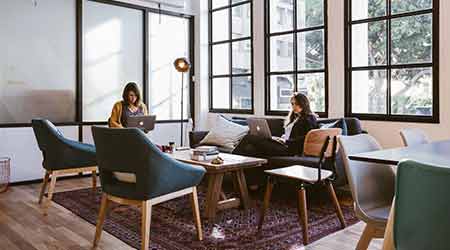« Back to Facilities Management Commercial Office Facilities Category Home
Does Your Workplace Have What Employees Want?

In today’s world, design trends are merging: A shared public space in lower Manhattan is designed with the same guiding principles as WeWork in Tel Aviv.
Photo: WeWork
October 10, 2018
- Commercial Office Facilities
By Aytan Litwin
I recently met with a journalist friend, who invited me to lunch at his media company’s new, luxe cafeteria. Aesthetically, the cafeteria felt like an Apple Store, but homier: clean curves of white plastic juxtaposed with stiff, straight chrome, and the kind of wood paneling you imagine line the walls of the swankiest Swedish ski resorts. The room was illuminated by bright, warm lights that made everyone inside look a little more glamorous.
The magazine publishing company’s aesthetically modern cafeteria is exemplary of the way that, in today’s world, design trends are merging. A shared public space at Conde Nast in lower Manhattan is designed with the same guiding principles as WeWork in Tel Aviv.
Those guiding principles call for spaces that are wide open, airy, full of light and energy, with as many floor-to-ceiling windows as possible, to illuminate the space inside and to connect people to the vibrant urban environment right outside.
The buzz in the cafeteria that day seemed to be filled with the energy of the company’s employees, and that’s just the point. To blur conventional lines between work and non-work through a more comfortable, open and collaborative spaces — spaces that foster creativity, relationships and positive workplace cultures.
This is where the Millennial mindset meets the workplace. They are a generation that is by nature collaborative and eager to mix business and pleasure in a way previous generations typically tried to avoid. So it’s a good strategy for those creating the working experience today to make sure their designs fulfill the cravings of Millennials, who have no qualms about leaving a role in a work environment that stifles their creativity.
• Employees today are seeking elevated aesthetics. The industry is embracing this, but not nearly fast enough. There is an increasing understanding that aesthetics influence culture, and that culture affects employees’ quality of life and — just as critically — the quality of the work that is collectively created.
• They want fun and surprise. This generation lives on Instagram and Snap; they’re used to fleeting yet inspiring visuals. Workspaces must work these in — which means not only a greater attention to every detail, but small “Easter eggs” that reveal the humanity and sense of humor of the creator. A fun fixture on a beer tap; an inspirational quote on a wall; a piece of provocative art in the conference room — these are the small but profound touches that matter. To attract the best Millennial talent, the workplace must be engaging (maybe more engaging than the work itself).
• Employees crave workspaces that are open late. As the workforce continues to blend (rather than balance) work and life, we will see changes in workplaces based on the need for 24/7 access. Workspaces are likely to become even more modular, the shapes and configurations easily changeable so workers can change their surroundings to fight boredom and foster creativity as they spend increasing amounts of time in the office at odd hours. This modular evolution will be especially true in common areas, and the death of the cubicle will help facilitate this change, by opening up more space and allowing for more imaginative possibilities in terms of furniture and design.
• They want physical flexibility. A friend of mine who studies workplace culture told me to watch the way Millennials work. It was a great insight. Previous generations sat in their chairs all day. However, Millennials alternate between sitting at their desks, standing up, and plopping on a couch. They want office furniture and spaces that enable this fluid behavior.
Of course, there’s a very likely chance that technology quickly improves to the degree that we are soon all using virtual reality headsets to enter digital conference rooms from anywhere in the world, as we collectively find new ways to work together. But so long as the physical workplace continues to exist — and so long as we have to leave home to visit it — it will likely grow ever more comfortable, beautiful, and homey.
Aytan Litwin is founder and CEO of White Space.








